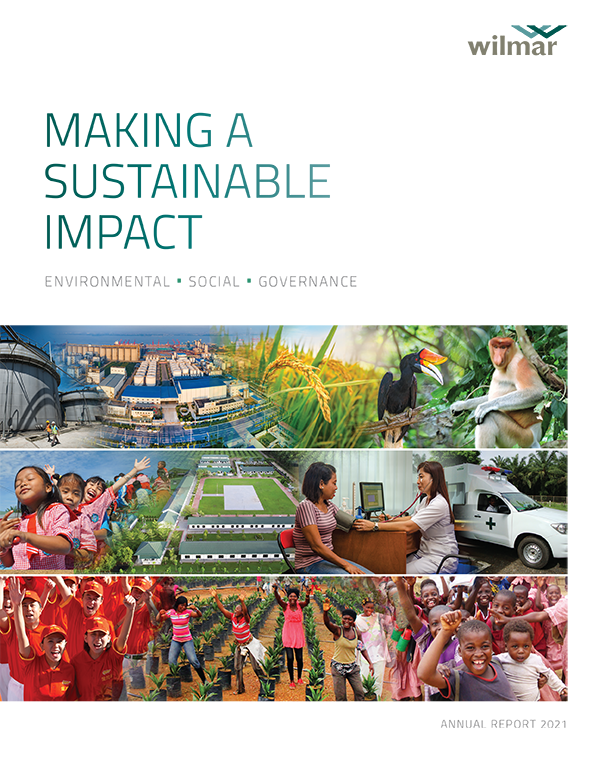PROTECTING OUR
ENVIRONMENT

At Wilmar, we firmly believe in leading by example and demonstrate this responsibility through our continued conservation efforts and investments. We are among the early adopters to identify High Conservation Value (HCV) areas and establish these areas as protected zones.
BIODIVERSITY AND CONSERVATION
Wilmar takes a proactive approach to environmental protection. We are committed to biodiversity conservation in our operations and supply chain, which extends from our overarching NDPE policy. Our commitment is guided by two main objectives:
- To manage, maintain and sustain biodiversity and ecological functions existing within conservation areas in Wilmar-owned operations and across the wider landscapes where we operate
- To strive to provide technical guidance and support to our stakeholders, including our suppliers, to enable the mainstreaming of biodiversity conservation in the plantation landscape
Our total conservation areas Group-wide are maintained at more than 32,000 hectares (ha). We remain steadfast in our commitment to No Deforestation and No Peat across our entire supply chain. Our focus is to increase yields and extraction rates to meet production demand without any further land clearing.
All identified HCV and High Conservation Stock (HCS) areas are monitored and maintained as conservation areas based on evaluations done to date for our palm oil operations. This work is carried out by a dedicated conservation team made up of a number of qualified High Conservation Stock Approach (HCSA) practitioners and licensed HCV-HCSA assessors.
Retaining forest connectivity:
The Sekar Imej conservation area in Malaysia
Wilmar has set aside total conservation areas of over 32,000 ha globally – roughly the size of Malta. Hence, it is imperative that Wilmar has a conservation strategy in place to preserve biodiversity and the environment. The Sekar Imej Conservation Area (SICA) is a picturesque forested area located within Wilmar’s plantation boundaries in the Beluran district of Sabah. At 2,469 ha, it is Wilmar’s largest conservation area in Malaysia, consisting largely of Lowland Mixed Dipterocarp Forest. The terrain is dissected and hilly, with steep slopes exceeding 25° angles. Given its hilly terrain, the conservation area is crucial for soil erosion control while providing clean water supply, habitats and refugia for mammals and birds.
To date, about 83 species of fauna have been recorded around SICA, many of which are listed as protected under the Sabah Wildlife Conservation Enactment 1997 and the IUCN Red List. Among the species of interest recorded include the Sunbear (Helartos malayanus), Lesser Mousedeer (Tragulus kanchil), Bornean Yellow Muntjac (Muntiacus atherodes) and birds such as the Oriental Pied Hornbill (Antheacoceros albirostris), and the Great Argus (Argusianus argus).
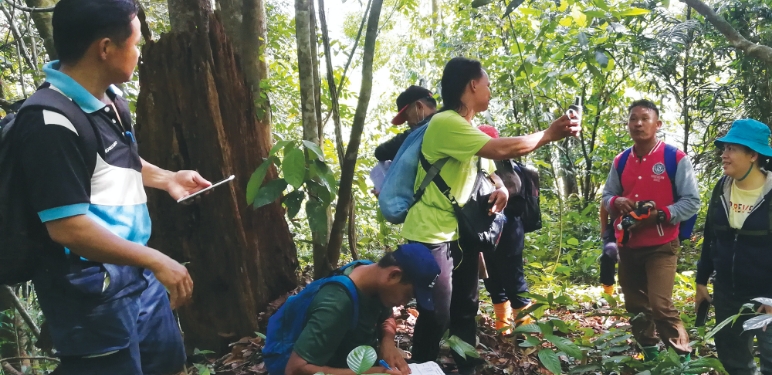 The Sekar Imej Conservation Area is our largest conservation area in
Malaysia. Wilmar’s conservation team carries out regular monitoring patrols here to identify
any possible encroachment, illegal hunting activities as well as to record wildlife
sightings.
The Sekar Imej Conservation Area is our largest conservation area in
Malaysia. Wilmar’s conservation team carries out regular monitoring patrols here to identify
any possible encroachment, illegal hunting activities as well as to record wildlife
sightings.
Peatlands store more carbon than all other forms of vegetation combined and therefore play a vital role in climate change mitigation. If these carbon-rich areas are drained or exposed to dry weather, they pose a risk of fire. Wilmar has prohibited any new development on peatlands, regardless of depth, since the implementation of our NDPE Policy. We research solutions for peat restoration where possible by collaborating with experts and local people as we recognise the opportunities and benefits these solutions provide, which includes reducing greenhouse gas (GHG) emissions.
About 1% of our total planted oil palm area is classified as peat. In these planted areas, we apply best management practices defined by peat experts together with the Roundtable on Sustainable Palm Oil (RSPO). This includes maintaining water tables at optimal levels to minimise peat subsidence and to minimise the release of carbon dioxide. We also participate in and contribute towards peatland conservation efforts and targets by the Indonesian Peatland Restoration Agency (Badan Restorasi Gambut) as well as in knowledge-sharing platforms and multi-stakeholder initiatives such as the Tropical Forest Alliance.
In addition to daily on-ground fire monitoring since 2020, we have harnessed technology to develop an integrated fire monitoring platform that automatically downloads hotspot data and relays it to our field managers using a web-based instant messaging application. The platform was developed internally by our geographic information system team. In 2021, the programme has been extended beyond Indonesia to Ghana, Malaysia and Nigeria.
We also continue to work closely with the RSPO in sharing fire-related data and verifying fire alerts through the RSPO Hotspot Monitoring Programme. Our response teams are immediately dispatched to extinguish fires once they are confirmed incidences.
Fire management programmes
in Indonesia
Wilmar has focused efforts to engage local communities in Sumatra and Kalimantan, Indonesia, where slash-and-burn methods are still practised by local farmers for land clearance and preparation, which they perceive to be cost-effective, enrich soil fertility and require minimal labour. We aim to engage local communities and raise awareness of the risks of using fire for land clearance and preparation, which are key components of our Fire Free Alliance (FFA) fire management programmes in Indonesia.
Since joining the FFA in 2016, we also established fire-risk maps within Wilmar-owned plantations and five kilometres beyond our concession boundaries based on soil type, past incidences of fire, accessibility to the area as well as proximity to population, roads and rivers. The maps support our efforts to better plan, monitor and manage activities, especially in high-risk areas.
We recognise the risks climate change poses to our planet and people, including livelihoods and agricultural activities which in turn adversely impacts food production and security. We are gearing up to mitigate the impacts of climate change while identifying the opportunities to strengthen our business resilience.
Our climate change initiatives focus primarily on our upstream agricultural activities, such as oil palm and sugarcane production, where our expected outcomes will be most significant. Additionally, our efforts run across our entire global presence which is aligned with the world moving towards a low-carbon economy.
At the World Leaders’ Summit on Forests and Land Use held at the Glasgow Climate Change Conference under the 26th UNFCC Conference of the Parties (COP 26) in November 2021, Wilmar was one of 12 companies that committed to developing a sectoral roadmap for enhanced supply chain action that is consistent with a 1.5°C pathway to be achieved by COP 27. The 12 companies have a combined annual revenue of almost US$500 billion and represent the major market share in key commodities including cattle, cocoa, palm oil and soy.
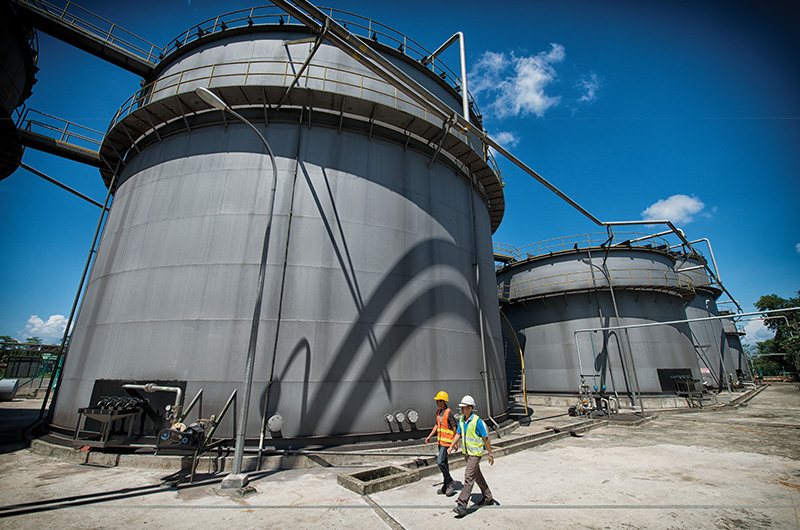 Biogas plants, such as this biogas tank system in one of our Malaysian
mills pictured here, utilise waste from our palm oil mills to produce energy, which in turn
powers the mills.
Biogas plants, such as this biogas tank system in one of our Malaysian
mills pictured here, utilise waste from our palm oil mills to produce energy, which in turn
powers the mills.
We rely on various resources including water and energy for our business to operate. We thus acknowledge the important role that we play in minimising the environmental footprint of our operations and to support sustainable production by implementing efficiency measures to reduce our use of resources. Our Environmental Policy sets out our commitment to minimise our environmental impact from all our operations. Where possible, we reuse, recover and recycle waste, while striving to responsibly manage disposed waste, effluents and chemicals. We also strictly comply with the relevant environmental laws and regulations in the countries where we operate.
In 2021, we commenced our global Industrial Sustainability Programme which focuses on driving efficiencies in energy, water and packaging in our factories. All our facilities, including those owned by our joint ventures, were surveyed as part of the programme and baseline data on energy, water and packaging were collected. We subsequently identified efficiency improvement projects to be implemented and worked with each site to determine reduction targets.
As of 2020, 56% of our Group-wide energy consumption was from renewable sources of energy, mainly generated from biomass, biogas and solar energy sources. Renewable energy remains a major part of our energy sourcing.
We rely mostly on renewable energy in our palm oil and sugar upstream operations that are generated from biomass, which is mostly derived from our operational waste. For our palm oil mills, the primary energy sources are by-products from the milling process, such as empty fruit bunches (EFB), kernel shells and mill fibre. For our sugar milling operations in Australia and India, the main source of fuel powering our mills is cane bagasse. We are one of the largest producers of renewable biomass energy in Australia.
We have adopted a range of different technologies in our factories to reduce our energy consumption and improve energy efficiency, including steam condensate recovery, waste heat recovery of exhaust gas and steam residual pressure power generation. These initiatives also result in significant GHG emissions reduction.
We are in the midst of implementing the Process Information Management System (PIMS) which monitors the key performance parameters of process and production in our manufacturing plants in real time on a cloud based platform. PIMS will enable us to track key parameters for overall equipment and process efficiency as well as the consumption of energy, water and raw materials across all production plants globally. It will also be able to detect deviations from key parameters and allow us to take corrective actions swiftly. Phase 1 of the implementation of PIMS has been completed and phase 2 is underway.
Photovoltaic power plants and reducing
emissions through methane capture
facilities in palm oil mills
In 2020, Yihai Kerry Arawana (YKA), our subsidiary in China, and Yihua Technology reached an agreement to construct photovoltaic (PV) power plants in all our factories across China. At our factory in Taizhou, a 1.557 MWp PV station was built on the roof of the building, generating power of up to 1,228,536 KWh and reducing GHG emissions by 1,057.5 metric tonnes (MT) CO2e. By the end of 2021, we aim to build a distributed PV station of more than 110 MWp, with an annual power generation of more than 109 million kWh. In addition, the design and construction of PV power generation projects take into consideration sustainable resources such as clean energy during the building phase.
To mitigate mill methane emissions, we have invested in methane capture plants across our operations. We use these for flaring, generating electricity or feeding into boilers to replace the burning of palm kernel shells. An operational methane capture facility can potentially reduce a palm oil mill’s GHG emissions by 90%. We achieved our 2020 target to complete the construction of 25 methane capture plants by the end of February 2020. With 25 methane captures in full operation, we estimated in 2015 to be able to avoid 500,000 MT CO2e of emissions annually. As of December 2019, we saw a 571,596 MT CO2e of total emissions avoided at all our mills, far exceeding our initial estimations.
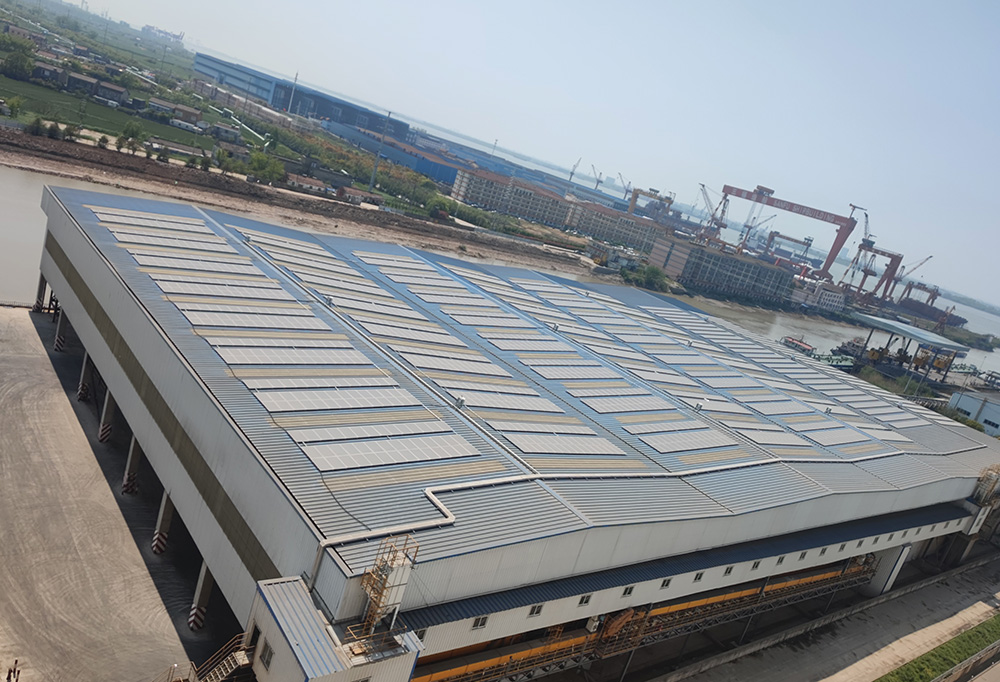 We are constructing photovoltaic power plants in all our factories in
China.
We are constructing photovoltaic power plants in all our factories in
China.
We are one of the world’s largest producers of biodiesel and the largest producer of palm biodiesel. Apart from first generation biofuels such as palm biodiesel and cane ethanol, we have capabilities to also produce second generation biofuels made from wastes and residues.
Palm biodiesel offers a cost-effective way to reducing reliance on fossil fuels in the energy transition world. Our palm biodiesel is compliant with the Group’s NDPE policy amongst other international sustainability standards.
Our biodiesel is non-toxic, safe to handle and meets the European (EN14214) and USA (ASTM D6751) standards. It contains virtually zero sulphur and is renewable and biodegradable, thereby burning cleaner and offering an improved carbon intensity than traditional petroleum-based fuel.
Our biofuels support government mandates focused on increasing the energy share from renewable sources and reducing reliance on fossil fuels. Such government mandates, like Indonesia’s B30 programme, act as a price support policy for oil palm farmers and in turn aid the government in managing the country’s foreign reserves.
Wilmar has adopted a lifecycle approach in the management of our water use in our oil palm plantations, from the design to the construction and running of our mills. We have also implemented water efficiency measures, especially for our water-intensive mills, nursery irrigation and household use. This helps us to reduce the use of water and enable cost savings in the long term. For example, in 2021, we explored ways to increase operational water consumption from wastewater recycled from our operations.
We also implemented comprehensive procedures to protect the quality of discharged water. We identify priority substances of concern in the water discharges and regularly monitor and report our progress in reducing significant pollutants. We adhere to all discharge limits specified in local regulations of the countries we operate in.
Wilmar also applies the principles of a circular economy, where possible, and is committed to reducing the amount of waste generated. We recover and reuse all the waste produced in our upstream palm activities, with organic waste including EFB, mesocarp fibre and palm kernel shells being used as fuel or organic fertiliser. Similarly, our sugar milling operations use cane bagasse as fuel for our boilers while other by-products such as press mud, ash, sludge and yeast sludge are used for soil enhancement purposes.
Manufacturing facilities designed to reduce
environmental footprint
Our large-scale integrated manufacturing complexes are built to reap operational efficiencies and minimise our carbon footprint. Different plants within the same manufacturing complex are able to share common infrastructure and utilities such as steam boilers, effluent treatment and storage tanks, which reduce energy consumption. The output from one plant is often the feedstock for another plant located in the same manufacturing complex thereby reducing transportation emissions. Further energy savings are achieved by using waste products from plants as feedstock for co-generation plants to produce steam and electricity for the manufacturing complexes.
In China, we are building central kitchens in integrated and landscaped Food Parks to manufacture quality food products at affordable prices for different customer segments. Located within or close to our existing integrated manufacturing complexes, our central kitchens will use oil, flour, rice, noodles and condiments produced by our factories to prepare convenient ready-to-eat yet fresh meals.
The Food Parks will house other central kitchen operators and food manufacturers to form a complementary eco-system of tenants with products and services that enhance quality and innovation. Through bulk purchasing of raw materials, consolidated deliveries, more efficient logistics, lower inventory and shared services such as boilers and effluent treatment, the Food Parks will be able to lower carbon emissions.
A new subsidiary, Yihai Shunfeng (Shanghai) Supply Chain Technology Co., Ltd, was formed in China in November 2021 to support the logistics and warehousing requirements of our Food Parks by consolidating deliveries and optimising distribution routes to destinations to reduce our carbon footprint.
The Food Parks will also provide food safety testing and inspection as well as quality control and assurance to ensure the strictest food safety standards are met.
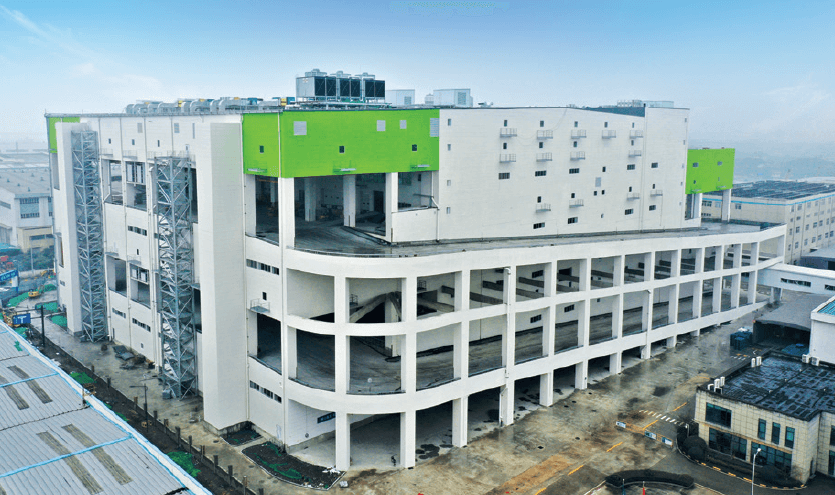 Central kitchen in Hangzhou, China.
Central kitchen in Hangzhou, China.
Minimising wastage through the
circular economy of rice
Since the establishment of our first rice mill in Heilongjiang, Jiamusi in 2006, we have invested more than RMB 1 billion in the research and development of a green and low carbon circular economy model for rice through intensive processing and maximising the usage of all by-products. This model is now adopted in all our rice mills in China.
In 2017, our rice mill in Jiamusi embarked on a pilot programme to implement a standardised circular economy model on a national level, with the approval from the National Development and Reform Commission and the National Standards Committee. In 2021, it became the official standardised circular economy of rice model that is included in the national green development plan.
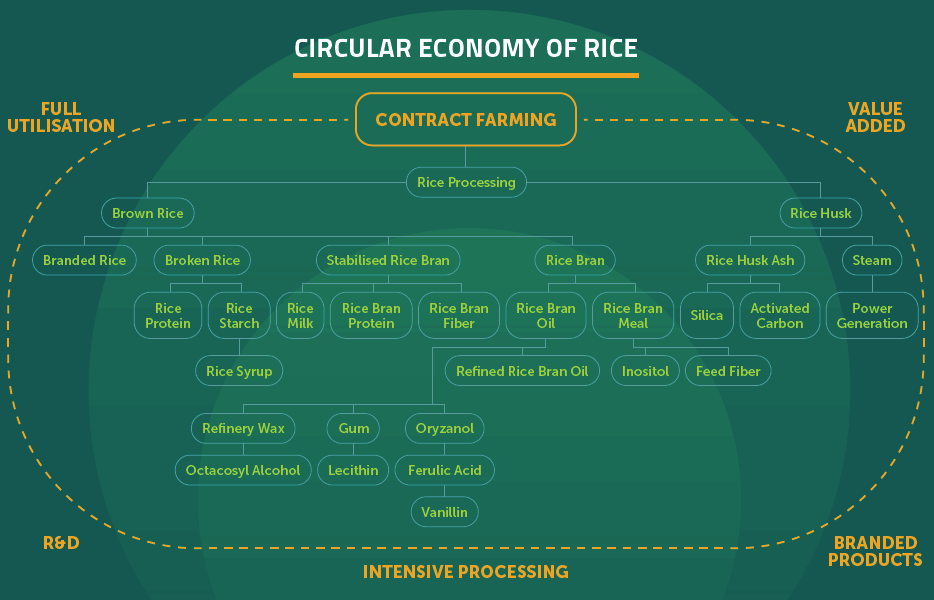
We work closely with our research and development (R&D) teams as well as the wider industry to develop packaging solutions using the least number of materials and those that can be reused or recycled by end-users. This is part of our effort to address the impact of packaging waste, particularly plastic waste, while still prioritising food safety and quality as well as seeking to lengthen product shelf life and reduce food waste. We have made significant progress with sustainable packaging across our businesses thus far.
We launched a Global Packaging Data Questionnaire in 2020 across our business units in an effort to collect comprehensive baseline data. It concluded that we used around 300,000 tonnes of plastic across our operations. We were also able to determine the material efficiency for plastics in general and identify areas where we can potentially increase efficiency. Material efficiency refers to the amount of product packed per tonne of plastic.
Aside from material efficiency, we are also exploring the use of bioplastics and recycled plastics while being mindful that some countries have strict restrictions on the use of recycled plastics for food packaging due to food safety concerns.
Sustainable packaging initiatives in China,
Australia and New Zealand
Yihai Kerry Arawana’s progress
In China, we have started factoring in product
circularity from the development stages of our
products. Packaging efficiencies are considered
from the beginning to the end of the product
lifecycle. Our projects include plastic, paper and
glass where we strive to reduce materials used for
plastic and rice bags as well as reduce polyethylene
terephthalate (PET) and glass bottles as well as
bottle caps.
We have also been reusing or recycling plastic into packaging not in direct contact with food and reformulating our plastic into single-type forms so that they are more easily recyclable.
Currently, we are using calcium-plastic boxes instead of cardboard boxes, which are reusable up to 100 times for intermediate product transfers.
Through jointly developing and optimising formulas with upstream raw material suppliers to reduce material consumption and improve performance, we have succeeded in reducing the usage of over two million woven bags and 85,000 plastic barrels by 2020. Concurrently, we are working with other industry players to conduct research on alternative plastic bags to reduce the packaging volume of rice and flour products.
We are introducing higher capacity options for our edible oil products to reduce the amount of raw materials used to make PET annually.
Goodman Fielder’s progress
In New Zealand, we were able to use 30% of recycled
high-density polyethylene (HDPE) plastic in our
milk bottles, representing 250 tonnes of recycled
plastic used instead of virgin plastic. To do this, we
had to remove the white resin colouring which
results in a clear plastic milk bottle. This allows the
bottles to be recycled into food-grade recycled
HDPE to make new bottles. While in Australia, we
launched a 100% PET mayonnaise jar and bottle
range, representing 380 tonnes of PET recycled. In
both Australia and New Zealand, all our bread tags
have been converted from polystyrene plastic into
cardboard, representing 300 million fewer items of
plastic produced.
